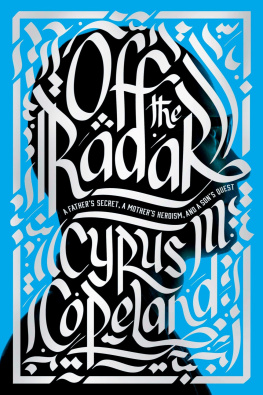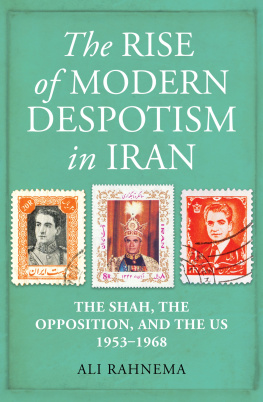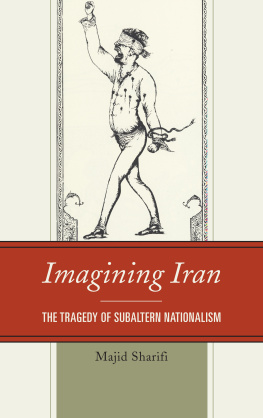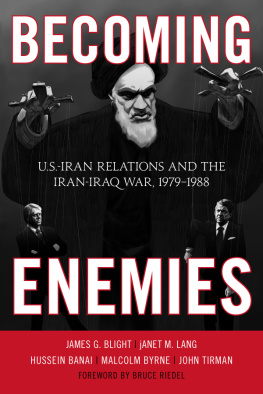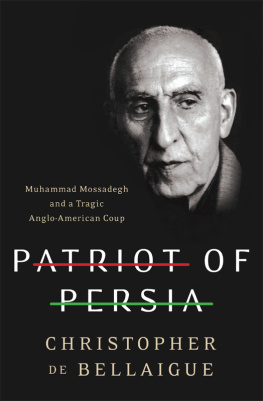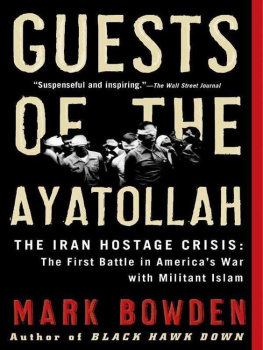Ehsan Bakhshandeh is Visiting Lecturer at the University of Tehrans Faculty of World Studies. He specialises in Iranian media studies and the concept of Occidentalism. He earned his PhD in international communication and journalism from the University of Westminster, UK. Ehsan is a graduate of Royal Holloway, University of London, where he studied Politics and International Relations at the postgraduate level.
OCCIDENTALISM
IN IRAN
Representations of the West in the
Iranian Media
E HSAN B AKHSHANDEH
Published in 2015 by
I.B.Tauris & Co. Ltd
London New York
www.ibtauris.com
Copyright 2015 Ehsan Bakhshandeh
The right of Ehsan Bakhshandeh to be identified as the author of this work has been asserted by the author in accordance with the Copyright, Designs and Patents Act 1988.
All rights reserved. Except for brief quotations in a review, this book, or any part thereof, may not be reproduced, stored in or introduced into a retrieval system, or transmitted, in any form or by any means, electronic, mechanical, photocopying, recording or otherwise, without the prior written permission of the publisher.
Every attempt has been made to gain permission for the use of the images in this book. Any omissions will be rectified in future editions.
References to websites were correct at the time of writing.
International Library of Iranian Studies 59
ISBN: 978 1 78453 162 1
eISBN: 978 0 85773 912 4
ePDF: 978 0 85772 548 6
A full CIP record for this book is available from the British Library
A full CIP record is available from the Library of Congress
Library of Congress Catalog Card Number: available
I dedicate this book to Professor Mohammad Mehdi Forqni, founder of Irans first College of Communication and outstanding researcher of journalism and media studies
LIST OF ILLUSTRATIONS
One definition of Occidentalism using similar words. Source: author.
Conservatism triangle of principles. Source: author.
Front page of Todays Man weekly newspaper, 7 April 1944. Source: Amin (2001).
A cartoon from The Fire weekly newspaper, 22 April 1944. Source: Amin (2001).
LIST OF TABLES
An AngloPersian chronology up to 1925. Source: Denis Wright, The Persians amongst the English: Episodes in Anglo-Persian History (London: I.B.Tauris, 1985), pp. 21620.
Number of Iranian press and news agencies in 2007. Source: author.
Number of Iranian press based on publication period. Source: author.
Number of Iranian press based on distribution range. Source: author.
Number of employees in the Iranian press and news agencies. Source: author.
Number of employees in the Iranian press and news agencies based on gender. Source: author.
Number of employees in the Iranian press and news agencies based on level of education. Source: author.
Number of employees in the Iranian press and news agencies based on type of contract. Source: author.
Number of employees in the Iranian press and news agencies based on job experience. Source: author.
Front-page headline issues in major Iranian newspapers. Source: author.
Editorial issues in major Iranian newspapers. Source: author.
Foreign news issues in major Iranian newspapers. Source: author.
Place of the event covered in the news in major Iranian newspapers. Source: author.
INTRODUCTION
With the election of Hassan Rouhani as the president of the Islamic Republic of Iran in 2013, ordinary Iranian citizens' hopes for a better life and relief from their economic hardship grew. Days before the elections, my taxi driver joked with me, in the Persian language, that Pride resid be Xantia, Mahdi biya Mahdi Biya, which literally means the price of the Pride, a cheap low-class sedan produced by Iran and sold at about 80 million rials in 2010, had increased to the price of the Xantia, an expensive high-class car made by Peugeot and traded at 200 million rials in 2010, and now it was time for Hazrat Mahdi, the twelfth Shiia Imam, to reappear and come out of hiding (to end injustice and punish criminals). After President Rouhani's election the same taxi driver told me that Rouhani is going to restore relations with the West and we can ask Hazrat Mahdi to remain hidden! The driver actually meant conditions would improve and there was no need for the Imam to re-appear.
The issue of relations between Iran and the West, particularly the United States, has always been a hot topic, especially during the elections in both Iran and the United States. Ronald Reagan won the 1981 elections and became the fortieth US President shortly after Iran released American hostages. Thirty-two years later, Hassan Rouhani became the seventh president of the Islamic Republic of Iran after he reportedly called, in one of his election campaigns in the Sharif University of Technology, for direct talks with the United States as Americans are the so-called Kadkhoda [chief of the village], therefore, if we deal with the Kadkhoda, it would be easier for us to deal with someone with a lower position. He later denied the remarks but had a historic telephone conversation with President Obama on returning from the 2013 UN General Assembly the first highest-level direct talk between the presidents of the two countries after the 1979 Islamic revolution. This 15-minute conversation took place after positive talks between Secretary of State John Kerry and Iranian Foreign Minister Mohammad Javad Zarif a day earlier.
Obama told reporters that while there will surely be important obstacles to moving forward and success is by no means guaranteed, I believe we can reach a comprehensive solution. Rouhani said in a tweet that the two presidents expressed their mutual political will to rapidly solve the nuclear issue.
Nearly two months later, Iran and the West reached an interim agreement to resolve the nuclear issue permanently in the future. The deal was rejected by Iranian hardliners, who intensified their anti-American rhetoric and the famous down with the USA slogan.
In the Persian language and contemporary literature, the word West has been equivalent to Farang (or Farangestan) and more recently to Maghreb or Gharb. In fifth-century Iranian literature, Farang was a title given to France which gradually became used to refer to all the West.
Little research has been undertaken into the representations of Europeans in Iranian works before the eighteenth century. Cole undertook an analysis of eighteenth-century depictions of the West in three Persian texts by upper-class Indo-Iranian authors: Abdollatif Khan (1805), Mirza Aboutaleb Khan (1812) and Aqa Ahmad Behbahani (1810). Cole recognised two paradoxical conceptions of the West (Britain in Cole's analysis) among Iranian intellectuals:
[Intellectuals] became divided between those who opposed the expansion of European [Western] power in the Muslim world and those willing to ally themselves or collaborate with the foreigners. Sometimes the career of a leader demonstrated both leanings, with early opposition to the foreigners followed by a collaborationist phase in the wake of a decisive defeat in the British hands.
In his analysis, Cole discovered three positive themes about Britain in the authors' works: egalitarianism (particularly with regard to gender relations and women's dress code); the system of government (parliamentarianism); and scientific and technological advancement (as in the printing press, shipbuilding, arms manufacturing and industrial mechanisation).



